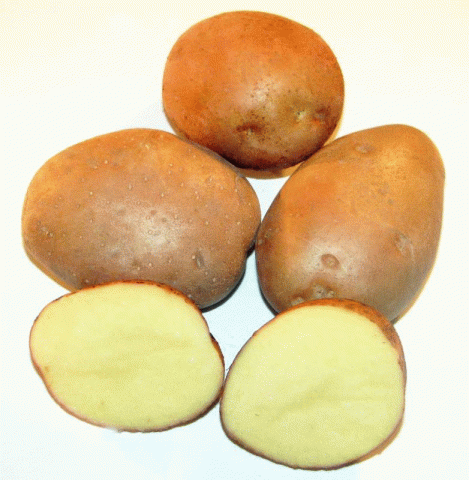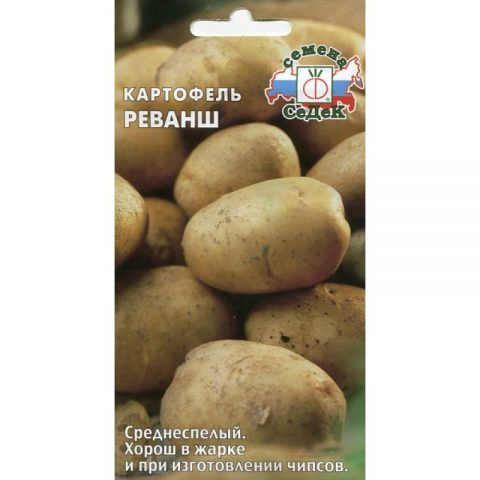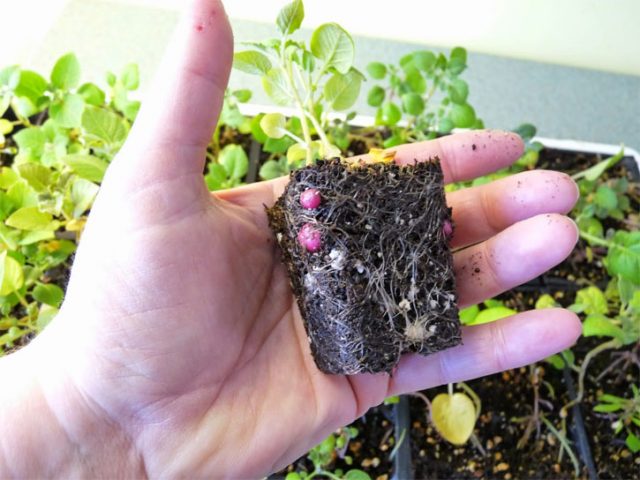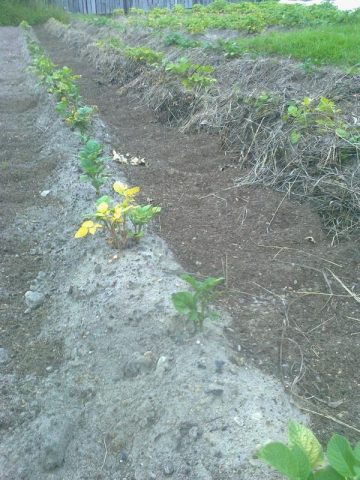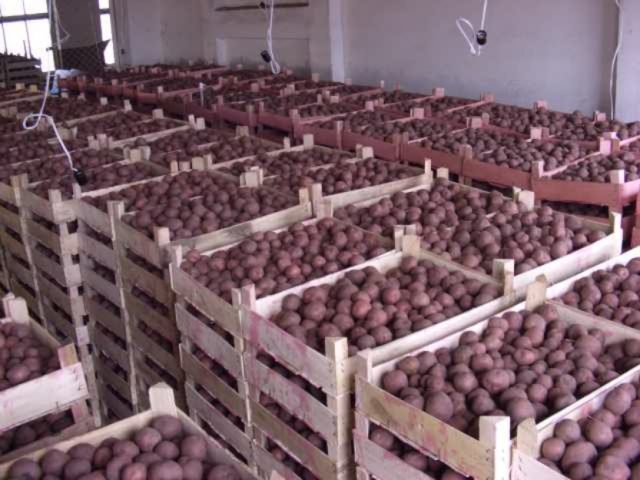Content
A description of the Revenge potato variety, photos and reviews about it will help gardeners decide whether a crop is suitable for planting in a particular region, and what yield can be expected. This potato belongs to large-fruited, high-yielding varieties with good taste. Revenge potatoes are planted commercially and on private plots.
Description of potato Revenge
Revenge potatoes are mid-season high-yielding varieties. The tubers have a rounded-oval shape, each weighing up to 120 g. The peel on the vegetable is strong, smooth. In the section, a light yellow color of the pulp can be noted, which does not darken during the cooking process.
Thanks to the strong skin, the potatoes of this variety have good transportability, and the tubers can also be stored for a long time in appropriate conditions.
Revenge potato bushes are tall, powerful, well developed.
Taste qualities of potatoes Revenge
Revenge potatoes are classified as multipurpose varieties. Root vegetables are used to prepare various dishes, they cook quickly, and do not lose their shape when frying. The tubers taste good. The variety is often used for the industrial preparation of chips, French fries.
Pros and cons of the variety
Each potato variety has its own positive qualities. The advantages of the Revenge variety include:
- increased resistance to golden nematode, which can cause significant harm to other varieties. Yield losses in case of a golden nematode infection can be up to 80%;
- resistance to mechanical damage;
- good portability;
- long shelf life. In a cellar, potatoes are stored until the next harvest;
- adaptability to the climatic conditions of the region;
- large weight of tubers;
- good taste and use for cooking any potato dishes.
Planting and caring for potatoes Revenge
The Revenge variety is suitable for growing outdoors and in greenhouse conditions. To obtain a high yield, it is necessary to adhere to the rules of agricultural technology.
Selection and preparation of the landing site
Revenge potatoes prefers sunny areas, so the beds are chosen in the southern, southeastern or southwestern territories. Lowlands where water accumulates are not suitable for growing potatoes. Clayy soils do not allow achieving good yields. The best option is light sandy loam soils with a loose composition, chernozem or peat soils.
If the site is located on clay soil, the situation can be corrected by adding sand, wood ash, manure, humus to the soil.
In the spring, before planting Revenge potatoes, the land must be loosened. If the soil is good (sandy loam), it is enough to loosen by 15–20 cm. For clay soil, it is recommended to carry out two treatments. First, a slight loosening is performed to a depth of 15 cm, when planting, the site is dug to the depth of the shovel bayonet, and the lumps are leveled with a rake. This helps to eliminate excess moisture in the area and saturate the earth with oxygen.
The predecessors in the garden where you plan to plant potatoes can be: cabbage, cucumbers, beans, sorrel, lettuce, spinach.
Preparation of planting material
If potatoes are planted with seeds, they are pre-soaked in water for 48 hours. You can use the seed hardening method.To do this, the soaked seeds are placed in the refrigerator overnight, and during the day they are pulled out and kept indoors at room temperature. The hardening process takes ten days.
Tuber preparation is carried out using various methods:
- germination is the most effective method, accelerating the formation of new tubers and increasing the yield. Dry germination is carried out in boxes, the process takes about 30 days. For wet germination, Revenge potatoes are placed in boxes with wet peat or sawdust. The advantages of this method are that the preparatory period is reduced to 15–20 days;
- the drying method is used if there is little time before planting the potatoes in the ground. The tubers are kept warm for 7-10 days;
- potatoes can be warmed up 3-4 days before planting. This is done gradually, the first 1-2 days the tubers are kept at a temperature of +15 ° C, then they are transferred to a warmer room (+20 ° C).
Landing rules
If planting is carried out by seeds, then they are sown at the end of March or at the beginning of April. The boxes are filled with a moist composition consisting of earth and peat in a ratio of 1: 4. Seedlings are planted in rows. The distance between the adjacent seeds should be 5 cm, and between the rows - 10 cm. The naklyuvshuyuschaya seeds should be covered with sand, the layer should be no more than 0.5 cm. Boxes with seedlings are covered with foil or glass and transferred to a warm room, you can use a greenhouse. The first shoots appear in about 7-10 days. After two real leaves appear on the stem, the seedlings dive into peat or plastic cups.
Seedlings are watered and the soil is loosened. After the threat of frost has passed, the seedlings are planted in the beds. For this, holes are prepared:
- the depth of the fossa is about 10 cm;
- humus is brought to the bottom - 300 g;
- watered with 0.5 liters of water.
The seedlings are deepened so that the top with three leaves is on the surface.
If the daytime and nighttime temperatures differ significantly, the Revenge potato seedlings are covered with foil. After warm nights are established, the shelter is removed.
If potatoes are planted with tubers, the soil temperature should be at least 10 ° C. The deepening of potatoes depends on the soil:
- on sandystones and fertile soils, tubers are buried by 10–11 cm;
- if the soil is clay, the depression should not exceed 8 cm;
- in the southern arid regions, tubers are laid to a depth of 12 to 15 cm.
The recommended planting pattern is 30x60 cm.
Watering and feeding
The frequency of watering depends on the weather in the region and the quality of the soil. Sandy soils dry out faster, so more frequent watering is required. Revenge potatoes are a moisture-loving crop that suffers from a lack of moisture. The minimum number of waterings per season is 3 times:
- after the emergence of seedlings, the soil must be moistened;
- the second time watering is carried out during the appearance of buds;
- after the completion of the flowering process, the plant is watered again.
Approximate water consumption per 1 m² - 50 liters. The water should be warm (+23 ÷ +25 ° C). To avoid increased evaporation of moisture, watering is carried out in the morning or evening.
If the summer is dry, the Revenge potatoes need additional watering. It can be carried out into furrows, the drip system is effective. Sprinkling can harm the bushes, since a humid environment promotes the development of fungal diseases.
To increase the yield of potatoes, top dressing is used. They are held three times per season:
- 20-30 days after planting, a mixture of urea and mullein is used. Mullein or bird droppings are added to water (1: 4) and kept for 7 days. For 1 bucket of water add a solution of droppings and 1 tbsp. l. urea. Pour 0.5 liters of nutrient composition under each bush;
- during the appearance of buds on potatoes, fertilizing with wood ash and potassium sulfate is needed. A bucket of water will require 1 glass of wood ash and 1 tbsp. l. potash fertilizer. 500 ml of solution is poured under the bush;
- after the potatoes have bloomed, one more top dressing is added.For 10 liters of water add 200 ml of mullein and 2 tbsp. l. superphosphate. Consumption - 0.5 liters for each bush.
You can use additional feeding. To prepare nettle infusion, you will need a bucket of water, crushed shoots and nettle leaves, wood ash (1 glass), yeast - 50 g. After a week of fermentation, the composition is diluted with water (1:10) and the tops are sprayed.
Loosening and weeding
A week after planting the Revenge potatoes, the first weeding of weeds in the garden is carried out. Loosening done during the day helps to eliminate about 80% of the appearing weeds.
For the full development of tubers, loose soil is needed. After rains, the earth is compacted, therefore it is recommended to loosen the soil after precipitation.
Hilling
The first hilling is carried out after the shoots have stretched up to 15 cm.The procedure is performed as needed, but at least 2 times per season. The second hilling is carried out about two weeks after the first, while the potatoes should not bloom yet. Additional hilling may be required if potatoes are peeking out of the ground. The tubers must be covered with a layer of soil.
Diseases and pests
The most common and dangerous pest of various varieties of potatoes is the Colorado potato beetle. The offspring of just one pair of insects can spoil up to 4 hectares of potato plantings. In small areas, it is recommended to collect beetles and larvae manually, and on an industrial scale, processing is carried out with chemical and biological products.
Insects damaging potato tubers - wireworms, darkling beetles, click beetle larvae. They not only spoil the tubers with their own moves, but also spread the pathogens of rot. Control measures are to carry out crop rotation. In the beds after potatoes, it is recommended to plant legumes that are not affected by these insects.
To combat the bear in the beds, deep plowing and loosening of the soil are used. In the spring, before digging, you can decompose bait poisoned with chemicals on the site.
Viral diseases (wrinkled mosaic, mottling, gothic) lead to the degeneration of the potato. The disease can be carried by insects - aphids, cicadas. Sick bushes must be destroyed.
Bacterial diseases - rot, black leg cannot be treated. Diseased plants are dug up and burned.
Potato yield
The yield indicator depends on many factors: the quality of the land and planting material, proper care and weather conditions. The Revenge potato variety is high-yielding. According to gardeners, 2.5 kg of potatoes can be harvested from one seed planted. The peak yield of the Revenge falls on the second - third year, after which it is advisable to plant seeds.
Harvesting and storage
The ripening period for Revenge potatoes takes from 90 to 110 days, it all depends on the region and climatic conditions. Harvesting is carried out after the tops have dried, when it is still possible to determine the location of the bushes.
The potatoes are harvested in dry weather and allowed to air dry in the shade of trees. Then they are only transferred to basements or cool storage rooms.
The first two weeks the potatoes are stored at a temperature of about 18 ° C, then the temperature is lowered to 12 ° C, after 10 days the temperature is set in the range from 2 to 5 ° C. Under such conditions, the Revenge potatoes can be stored until spring.
Conclusion
Description of the Revenge potato variety, photos and reviews of gardeners, allow us to conclude that this crop is suitable for growing in various regions of Russia. Proper care and compliance with crop rotation are the main components of a high yield indicator.
